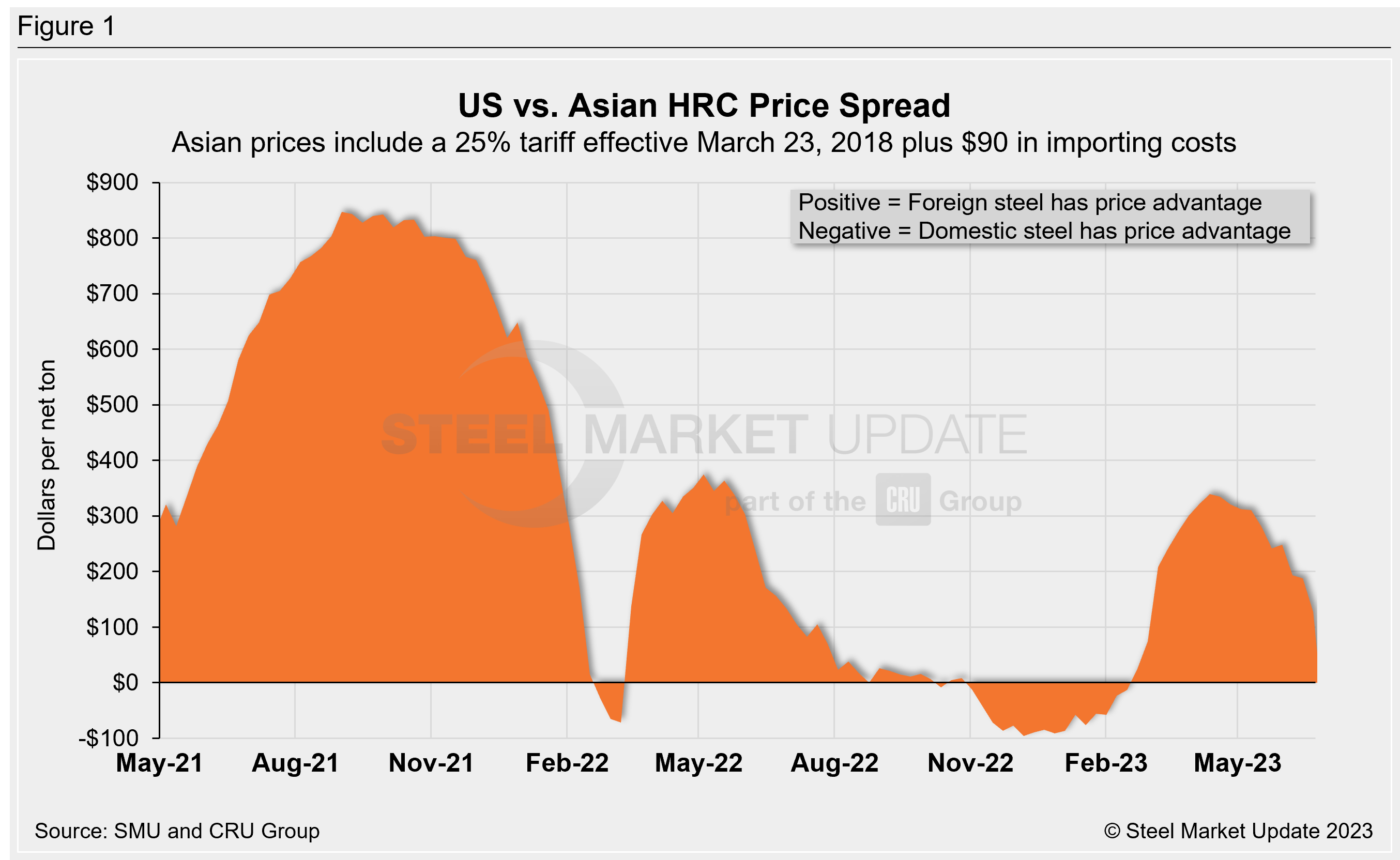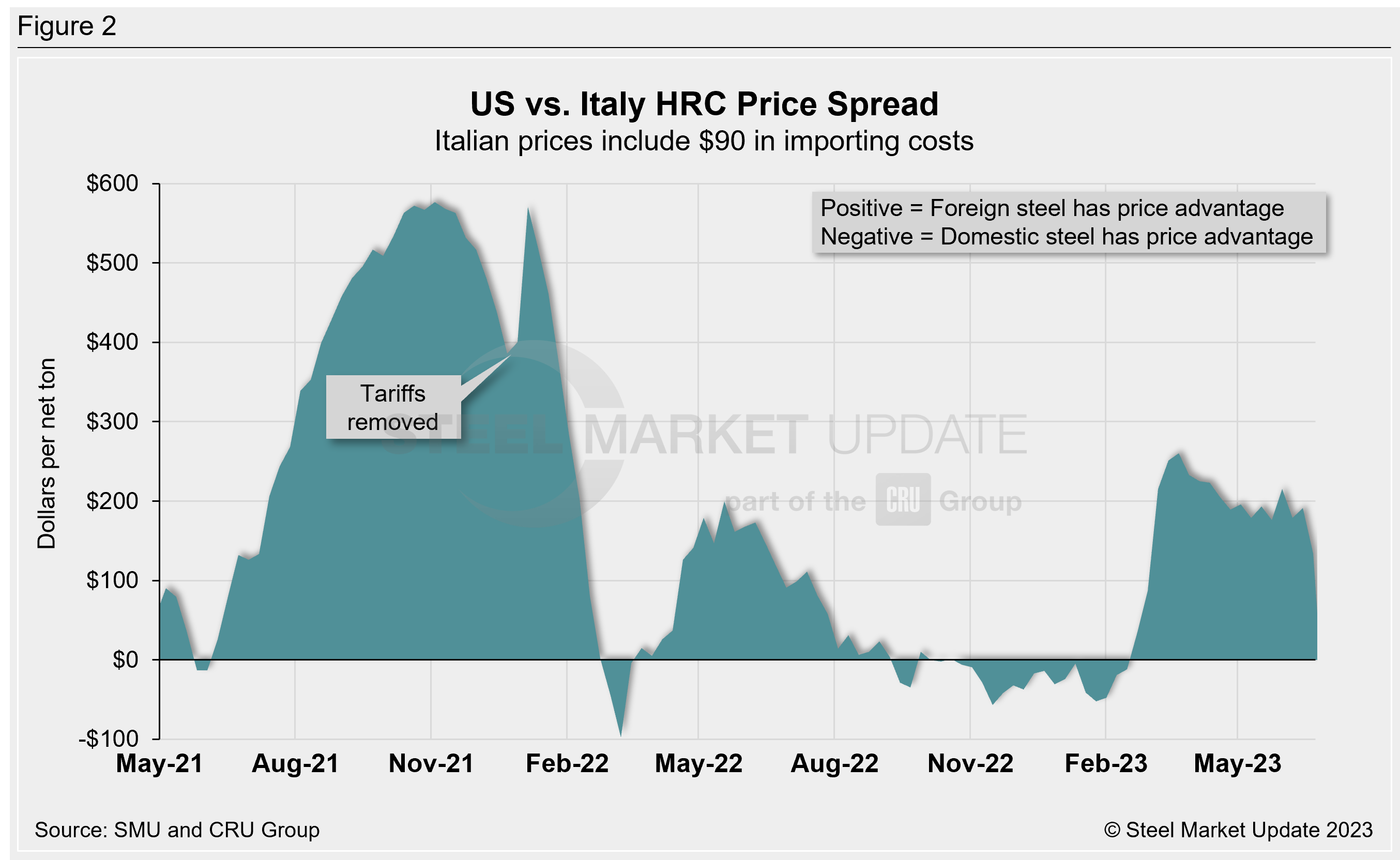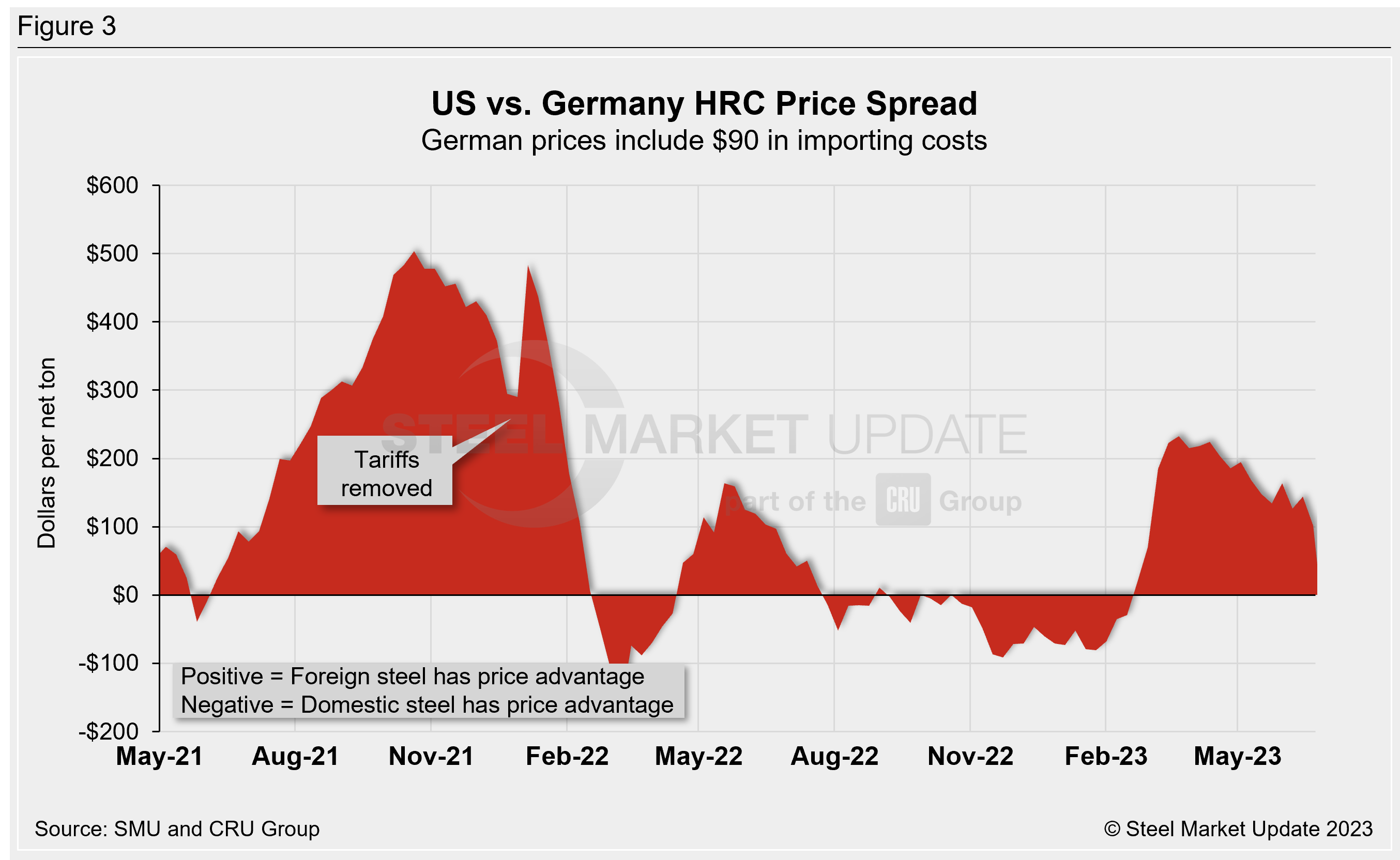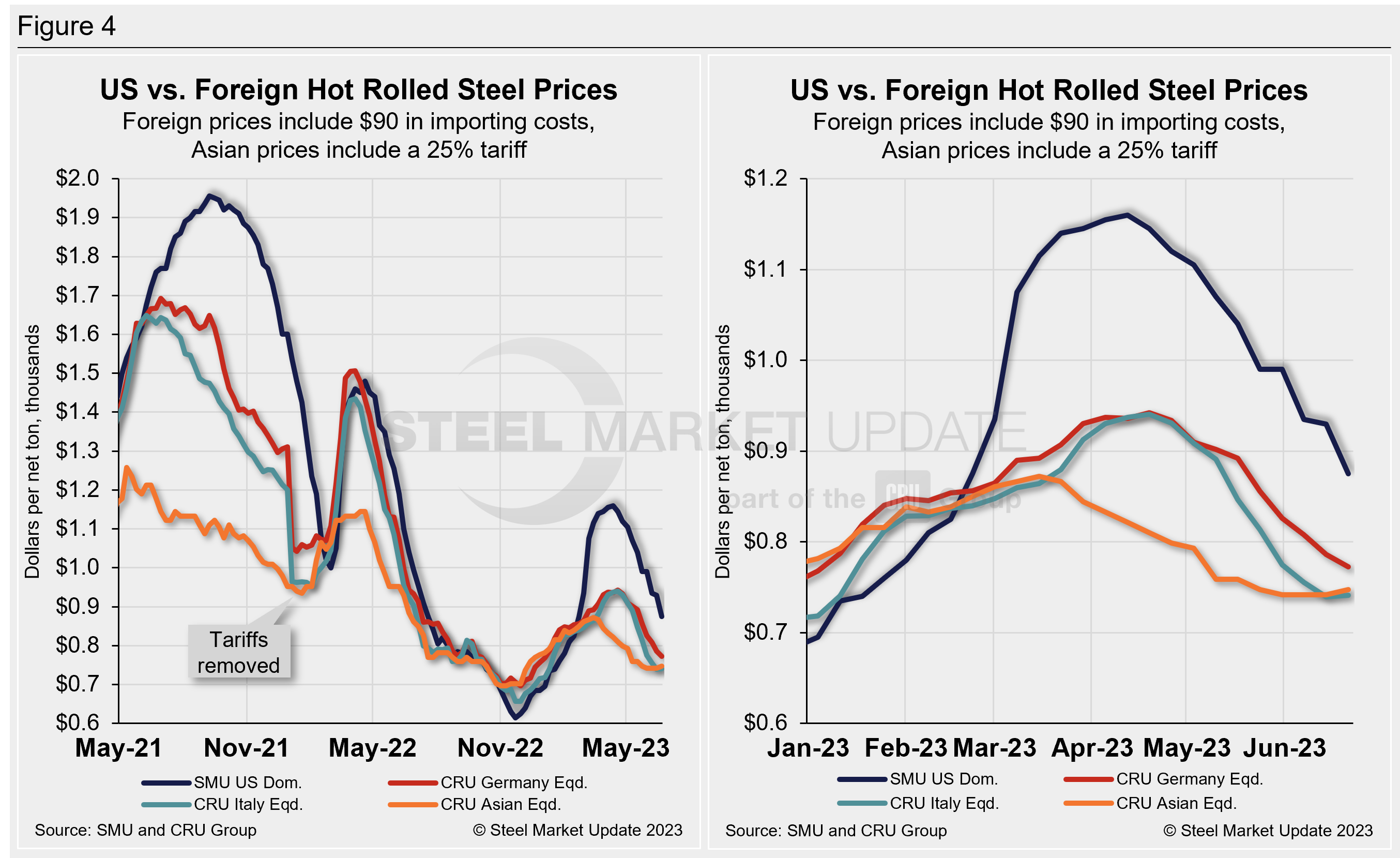SMU Data and Models

US Premium Over Foreign HRC Hits a Four-Month Low
Written by David Schollaert
June 22, 2023
Offshore hot-rolled coil (HRC) remains at a discount to domestic product, though the US premium is at its lowest mark in nearly four months, according to SMU’s latest foreign vs. domestic price analysis.
Prices for hot band stateside have eroded sharply over the past few weeks, down $115 per net ton so far in June, effectively tightening the discount of foreign HRC over US product.
![]() When US prices began trending downward towards the end of 2022, domestic HRC held a price advantage over imported material for about four months,. Repeated mill price hikes to kick off the year then ballooned the US premium over offshore hot band by more than $260 per ton.
When US prices began trending downward towards the end of 2022, domestic HRC held a price advantage over imported material for about four months,. Repeated mill price hikes to kick off the year then ballooned the US premium over offshore hot band by more than $260 per ton.
Domestic hot band is now roughly 14% more expensive than foreign material, down from about 19% a week ago. While the margin is now at its lowest since March 1, it could be short-lived if domestic mills are successful in their latest efforts to prop up prices.
As recently as Feb. 15, domestic HRC cost on average $18 per ton less than imported HRC. That flipped mid-Q1 when US prices became $262 per ton on average more expensive than offshore product. The premium is now down $63 per ton, as domestic prices are on average $121 per ton more expensive than imported hot band.
SMU uses the following calculation to identify this theoretical spread between foreign HRC prices (delivered to US ports) and domestic HRC prices (FOB domestic mills): Our analysis compares the SMU US HRC weekly index to the CRU HRC weekly indices for Germany, Italy, and east and southeast Asian ports. This is only a theoretical calculation because costs to import can vary greatly, influencing the true market spread.
In consideration of freight costs, handling, and trader margin, we add $90 per ton to all foreign prices to provide an approximate CIF US ports price to compare to the SMU domestic HRC price. Buyers should use our $90-per-ton figure as a benchmark and adjust up or down based on their own shipping and handling costs. If you import steel and want to share your thoughts on these costs, we welcome your insight at david@steelmarketupdate.com.
Asian Hot-Rolled Coil (East and Southeast Asian Ports)
As of Thursday, June 22, the CRU Asian HRC price was up $4 per ton vs. the prior week, now at $526 per ton, unchanged from levels one month ago. Adding a 25% tariff and $90 per ton in estimated import costs, the delivered price of Asian HRC to the US is approximately $748 per ton. The latest SMU hot rolled average is $875 per ton, down $55 per ton from our previous price update, and down $115 per ton compared to our price one month ago.
US-produced HRC is now theoretically $127 per ton more expensive than steel imported from Asia. That figure is down $61 per ton week-on-week (WoW). This is still a reversal from mid-February when domestic HRC had a $13-per-ton advantage over HRC from Asian markets.

Italian Hot-Rolled Coil
Italian HRC prices also inched up WoW, up $2 per ton to $651 per ton this week, but they are down $173 per ton from a month ago. After adding import costs, the delivered price of Italian HRC is approximately $741 per ton.
Domestic HRC is now theoretically $134 per ton more expensive than imported Italian HRC. That spread is down $57 per ton WoW but still represents nearly a $150-per-ton reversal compared to just a little over three months ago when US HRC was $12 per ton cheaper than Italian hot band.

German Hot-Rolled Coil
CRU’s latest German HRC price slipped by $13 per ton WoW to $683 per ton, down $183 per ton from a month ago. After adding import costs, the delivered price of German HRC is roughly $773 per ton.
Domestic HRC is now theoretically $102 per ton more expensive than imported German HRC. That’s down $42 per ton WoW, yet still a swing of $131 per ton given that German hot band was $29 per ton more costly than domestic HRC mid-February.

Figure 4 compares all four price indices. The chart on the right zooms in to highlight this year’s decoupling of US and offshore HRC prices.

Notes: Freight is an important consideration in deciding whether to import foreign steel or buy from a domestic mill. Domestic prices are referenced as FOB the producing mill, while foreign prices are CIF the port (Houston, NOLA, Savannah, Los Angeles, Camden, etc.). Inland freight, from either a domestic mill or from the port, can dramatically impact the competitiveness of both domestic and foreign steel. It’s also important to factor in lead times. In most markets, domestic steel will deliver more quickly than foreign steel.
Effective Jan. 1, 2022, the traditional Section 232 tariff no longer applies to most imports from the European Union. it has been replaced by a tariff rate quota (TRQ). Therefore, the German and Italian price comparisons in this analysis no longer include a 25% tariff. SMU still includes the 25% Section 232 tariff on foreign prices from other countries. We do not include any antidumping (AD) or countervailing duties (CVD) in this analysis.
By David Schollaert, david@steelmarketupdate.com

David Schollaert
Read more from David SchollaertLatest in SMU Data and Models

SMU Scrap Survey: Current and Future Sentiment tick down
SMU’s Current Sentiment Index for scrap decreased this month, a move mirrored by our Future Sentiment Index, according to the latest data from our ferrous scrap survey.

SMU Survey: Buyers’ Sentiment slips again, future outlook improves
Each of our Sentiment Indices continues to reflect that steel buyers are positive about their present and future business prospects, though that confidence has eased considerably compared to the beginning of the year.

SMU scrap market survey results now available
SMU’s October ferrous scrap market survey results are now available on our website to all premium members.

SMU flat-rolled market survey results now available
SMU’s latest steel buyers market survey results are now available on our website to all premium members.

SMU Survey: Sheet and plate lead times stabilize
Sheet and plate lead times saw minor shifts this week, according to SMU’s latest market survey. Sheet times have inched up over the last month but remain within days of multi-year lows, as they have since May. Plate lead times have bobbed within a tight range for months, hovering roughly a week longer than this time last year.
